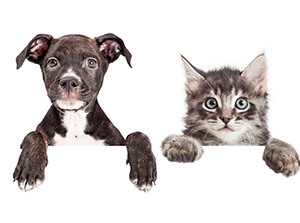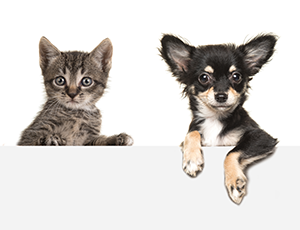First Aid for Pets

Accidents and emergencies aren’t just for humans. While first aid is no substitute for emergency veterinary care,
it is important for treating certain injuries and preventing symptoms or situations from worsening.
In critical emergencies opting to administer first aid before heading to your veterinarian could make the difference between the life and death of your pet.
As a pet owner, it is your responsibility to try and ensure the safety and well being of your pet at all times. With that in mind, here is our guide to basic first aid for pets.
Bleeding (Externally)
Usually the sign of a fight with another pet or an accident, external bleeding can be dealt with relatively quickly and simply unless it is severe and/or located on the legs.
You may need to muzzle your pet to establish the site of injury as he may be in some pain. Once you have located it, press a thick; clean gauze pad over the wound, applying pressure until the blood begins to clot. It may take a number of minutes for the clot to gain enough strength to sufficiently stop the bleeding, so instead of checking every few seconds, hold the gauze in place for at least two minutes before lifting it to check if the bleeding has ceased.
If your pet has severe blood loss from the legs then you should use a thin strip of gauze, elastic band or similar to create tourniquet between the wound and the body. Once it is in place you should cover it with a gauze pad and keep gentle pressure on the wound.
Loosen the tourniquet for around half a minute every 15 to 20 minutes so that you don’t cut the circulation off from the wound entirely, and get someone to drive you to an emergency veterinarian immediately as severe blood loss can be deadly for any pet.
Bleeding (Internally)
It may not always be possible to tell that your pet is bleeding internally, but some of the symptoms that you can look out for include:
Coughing up blood
Bleeding from the nose, mouth or rectum
Blood in urine
Pale gums
Rapid pulse rate
Weak pulse
Unconsciousness
If any of the above symptoms present themselves then you should make your pet as warm and
comfortable as possible and take him immediately to your emergency veterinarian.
Burns
If your pet suffers from any form of burn injury then you should muzzle him before applying large quantities of ice-cold water to the affected area.
In the case of chemical burns then the water should be free-flowing; cleansing the skin as much as possible. Otherwise, hold an ice-cold compress to the burned area and immediately transport your pet to your emergency veterinary service.
Choking
Choking is just as common in pets as it is in humans, and knowing how to assist your pet if he chokes could save his life. Symptoms of choking include:
Struggling to breathe
Pawing at the mouth and nose
Choking sounds
Excessive coughing
Lips or tongue turning blue
Your pet will be in an extreme state of panic and is more likely to accidentally bite you, so using caution you should try and look into his mouth and see if any blockages are immediately visible. If you can see something obstructing your pet’s airway you should carefully try and remove it using tongs, pliers or tweezers, taking extreme care not to push the item further into the esophagus. If it is not easily removed then don’t spend time repeatedly trying to reach it.
If you are unable to remove it or your pet collapses you should try and force air from the lungs in an attempt to push the object out from the other direction. The way you should do this is by putting both of your hands on the side of your pet’s rib cage and applying short sharp bursts of firm pressure.
Keep doing this until you manage to dislodge the foreign object or until you arrive at the emergency veterinary service.

Fractures
If you believe that your pet may have fractured a bone, he may be in considerable pain. Muzzle him if you can and then place your pet on a flat surface to support the fracture. Wrap a blanket or towel around him to keep him in place and then take him straight to your veterinarian. Unless you are a professional, we do not recommend that you use a DIY splint, as this can cause more harm than good.
Heatstroke
Far too many pets, especially dogs, die from being left in cars on warm days. Even if you don’t feel that it is particularly hot outside, the heat inside a vehicle can escalate very quickly through the glass so never leave your pet unattended in a vehicle.
Pets can suffer from heatstroke extremely easily. If your pet is panting excessively, he may be trying to cool himself down. Here is what you should do to help him:
Move him to a cool; shaded area.
Put a towel into cool or cold water and then wrap it around your pet’s head and neck; taking care not to cover his eyes, nose or mouth. The heat will be absorbed into the water so you should repeat this process every few minutes to ensure extremely cool water is being used.
If you can, use a hose so that cool water is continually running over your pet’s body. Pay special attention to the stomach and the area in between the hind legs as this is the area that retains the most heat. Use your hands to gently sweep the water away from its body.
Once you are satisfied your pet is cool enough to be moved, take him straight to see your emergency veterinarian.
Poisoning
Exposure to poison can be a common problem for pets and steps should be taken to ensure that anything containing hazardous chemicals, including human medication, is kept in a locked cupboard away from your pets.
As a general rule, anything that is toxic to human beings should also be considered to be harmful to your pet. However, there are also a variety of common food items that are hazardous to your pet. For a comprehensive list of pet poisons, we highly recommend you check out the Pet Poison Helpline website http://www.petpoisonhelpline.com/.
If you believe your pet’s skin has been exposed to a toxic product such as bleach or other cleaning product, use the information given on the product label for what you should do if a human came into contact with the chemicals and apply the same instructions.
If you believe your pet has consumed something harmful, contact the Pet Poison Helpline which is open 24/7 and give them as much information as possible about your pet and the type of poison you believe he may have consumed.
You should also collect anything that your pet has vomited and put it in a sealed bag so that you can take it with you to your veterinarian’s office.





